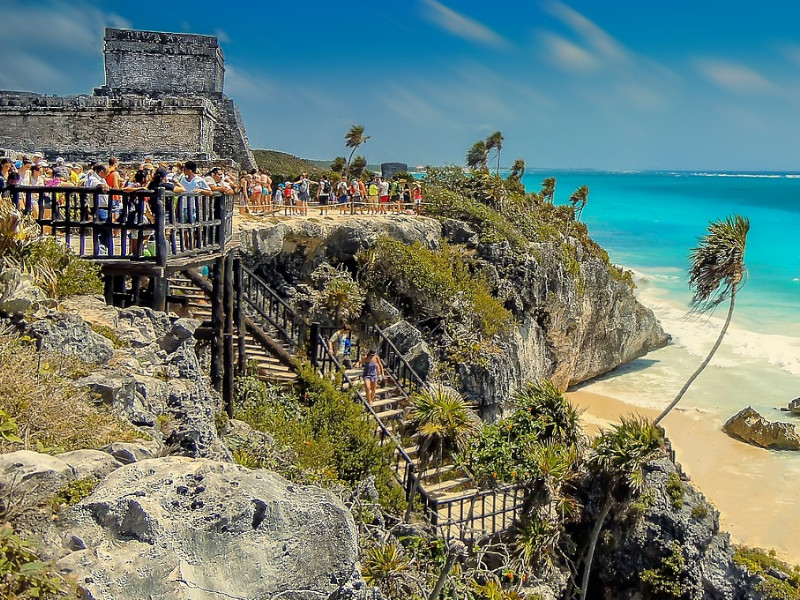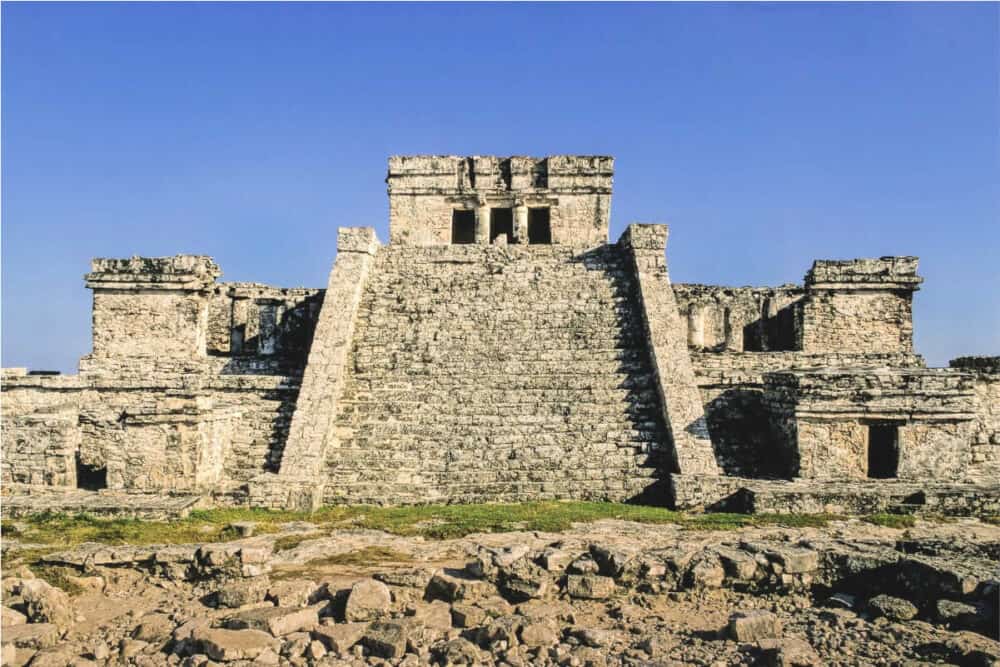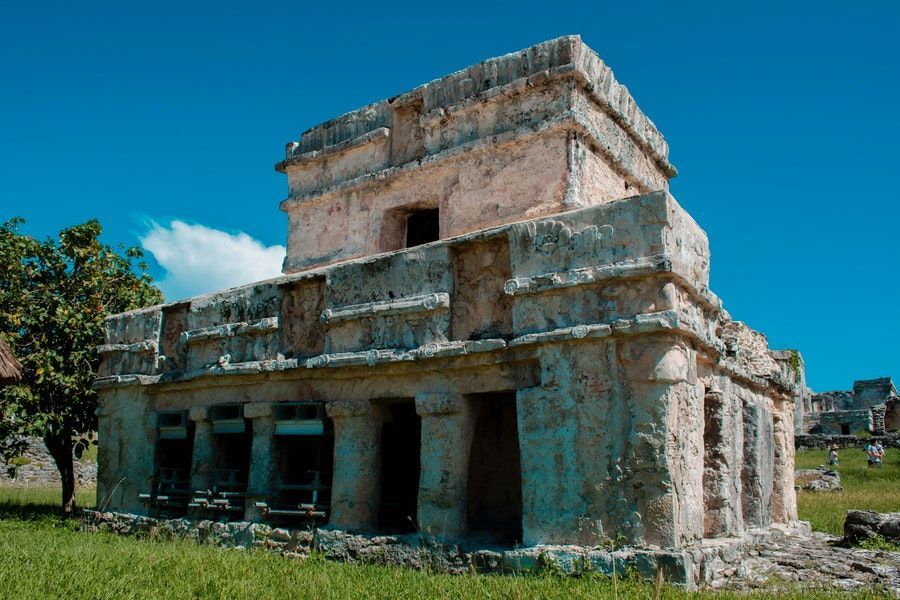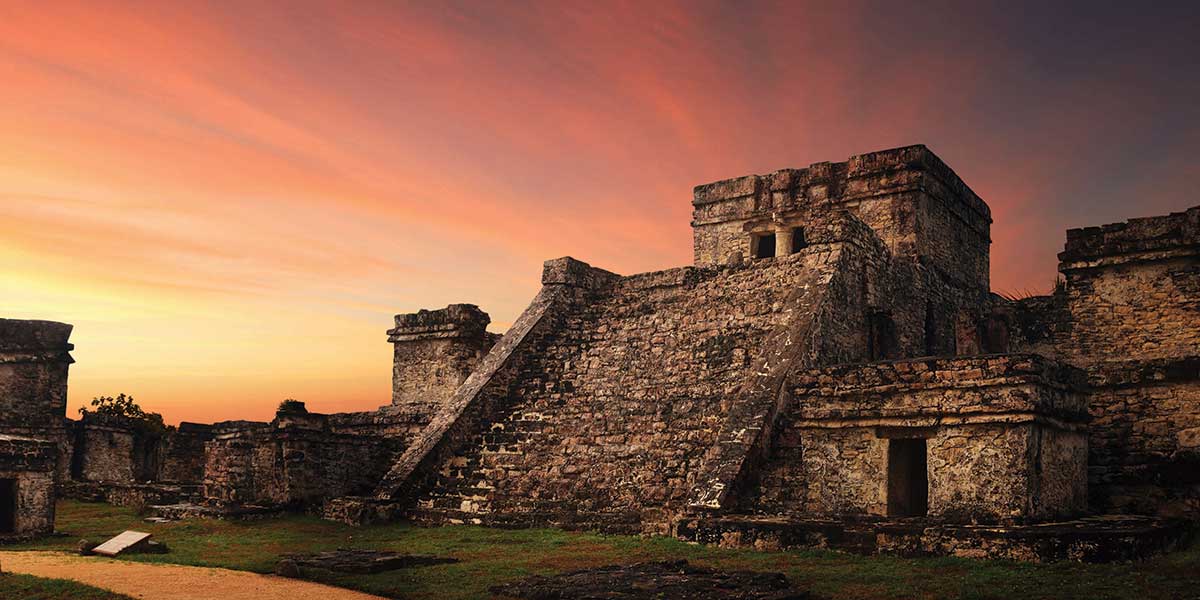Tulum is one of the most fascinating archaeological sites in Quintana Roo. It is located on the Caribbean coast of Mexico, 42 km south of Coba via highway 307.
Tulum was strategically built on a cliff over viewing the Caribbean Sea. Tulum is surrounded by a huge stone wall, Its height is irregular since it follows the contours of the land and it is rectangular shaped with only three sides; that which faces the sea was naturally protected.
Without a doubt, the wall had a defensive purpose although it also served to establish the limits of the “sacred” area. It has five doorways or entrances: one facing west, two to the north and two more to the south. From the inside, one can climb the wall by using the stairs specially built for this purpose.

Tulum Mexico
This city was also known as Zama (dawn) because of being in one of the places were dawn first breaks in our country.
The community was a commercial port with a privileged location; it was an active redistribution center for local and foreign products, some of which come from places as for away as Central America, the Pacific and Gulf coasts, and Central Mexico by sea, river and land routes.
Everyday life was intertwined with politics, magical religious rituals the arts, and astronomical observations, especially pertaning to the planet Venus -the morning and evening star-, the repetitive of Kukulkan -Quetzalcoatl–

Its rampart allowed it to control internal activities and, what’s more. to protect its residents; it marked the difference between the elite class and the common people, who lived outside the great wall.
Tulum was contemporary to Chichen Itza and Mayapan, and when the latter two states fell, it consolidated its position, paving the way for greatest period of expansion. Its decline began at the time Hispanic navigators arrived on its shores and islands from the on, a certain cultural cohesion was attained that has prevailed until the present time.
A secure sanctuary and trading port
The Mayas participated in the commercial circuit that extended from Central Mexico to Honduras, navigating along the coastlines, boys, coves, and inlets, as well as rivers, lakes, and estuaries.
Since their boats (canoes) couldn’t resist the turbulence on the open sea, they made sure to hug the coastline or to travel in shallow water as a means of protection.
On this trading circuit, Tulum was and important coastal port that linked land and sea trade.
Templo de las Pinturas
This building conserves most of the decorative elements of Tulum. It has two levels, of which the lower level is comprised of two temples, one within the other, were the decoration is concentrated.
The facade of the inner temple is decorated with mural paintings, while that of the outer temple boasts stucco figures in bas-relief, including mask in the corners, sculptures in three niches in the facade – the central one is a representation of the descending god – and human figures intertwined in the upper level is very simple as its decoration consists of red-colored hand prints
An architectonic and pictorial aesthetics of its own, influenced by Chichen Itza and Mayapan, The features of Tulum’s architecture are similar to those of Chichen Itza and Mayapan, with the incorporation of certain regional elements that characterize the East Coast style. The structures are small and show little complexity, height, or quality.
The walls are covered with stucco and on the facades there were modeled sculptures, as well as brightly colored paintings with a colorful finish and strong contrasts.

Religious life
Religious life and a pilgrimage to the sanctuary, a cultural expression associated with economics, politics, and nature. Mayan gods were present in one or more elements of nature. Some were manifest in the stars or in atmospheric phenomena like rain; others in plants like the ceiba (cotton silk tree) and animals like the jaguar. Each season of the year and each daily activity, such as the harvest, were marked by a ritual dedicated to a deity, aimed at making sure human labor would be rewarded with optimum results.
Planet Venus
Tulum was a city dedicated to the planet Venus, a deity with a dual nature; that of the morning and the evening star. The descending god symbolized by the setting Sun is closely to Venus, and so it can sold that the evening star was worshipped at Tulum; thus, the image of this deity is found on the facade of some of the buildings, and its, accesses are oriented to face the point where this planet sets. Another important deity was Ek Chuah, the god of trade, to whom tribute was paid in the course of commercial interchanges

Platforms with stairways are quite common in Tulum. The most important people of the zone built their houses of perishable materials on them.
Most of the constructions in Tulum are organized along what are called “streets”, with buildings grouped on the sides, especially residential platforms, upon which wood and thatch roofed houses were built, which have not survived due to the fragility of the materials.
The main constructions found in Tulum are:
- El Castillo (the castle), a temple with two columns portraying serpents
- A niche, where the Descending God is located
- The Temple of Paintings, containing frescos with sacred colors
Conclusion
Tulum has to be one of those mystical places in the Riviera Maya that you have to visit. Tulum is a wonderful place that you can’t leave out of your agenda, enjoy its ruins, its beaches, its sculptures, its unique atmosphere and don’t forget that if you don’t know how to get there, the best way to do it is through a private transfer to Tulum. See you in other posts.
